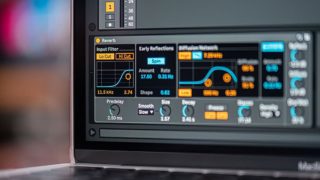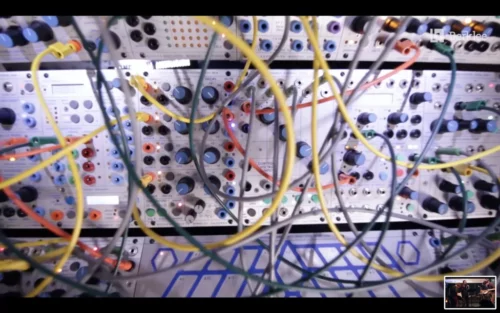19 Aug, 2022

Ableton has announced plans for Loop Create 2022 – an online “day of inspiration for music makers”:
“At this year’s edition of Loop Create, we’ll take a closer look at the ways people are making music together today; pooling their talents and ideas in collaborations, cooperating with each other to do things they couldn’t do on their own, and adding their voices to collective forms of creation for fun, profit and surprise.
Loop Create is an online day of inspiration for music makers, running for 6.5 hours, featuring interviews, workshops, an interactive production challenge and more. Join us on October 29th, as we explore the continuum of forms of collaboration.”
Find out more on the Ableton website.
4 Jun, 2022

Ableton has announced Ableton Live 11.2 is now available in public beta. Live 11.2 is an update that introduces an improved Reverb, adds support for AUv3 and many more.
Reverb has been updated with a refined interface, new Density controls, a new switchable filter, CPU optimizations and more.
Live now features native support for AUv3 plugins on macOS 10.15 or higher, meaning more options for Live users running their systems on Apple Silicon Macs.
New in Ableton Live 11.2 includes:
Capture MIDI
- Capture results are no longer influenced by the song tempo set by the target track’s previous Capture attempts.
- When Live’s transport is running, Capture MIDI will keep longer phrases in captured clips.
Control Surfaces
- In the Launchkey MK3 Control Surface script, the Quantise button can now quantize clips in Session or Arrangement View.
- On the PreSonus ATOM SQ, it is now possible to scroll between device parameter banks by holding the bank navigation buttons down.
- Fixed an issue in the SL_MKIII Control Surface script that resulted in incorrect LED button states when exiting Drum Mode.
- In the ATOM SQ Control Surface script, it is now possible to control the Master Track volume and pan in Song mode when the Master Track is selected.
- The encoder sensitivity for the ATOM SQ Control Surface script has been refined to better match the parameters they control. Additionally, the encoders can be used to fine tune parameter values when the Shift button is pressed.
Core Library
- Added audio and MIDI clips to Session View in Live’s Demo Song.
Interface
- The icons in Live’s Preferences and dialogs have been improved.
- Live now shows different icons for Live Clip (.alc) files that distinguish between Audio and MIDI content in the browser.
- When renaming tracks, [Tab] will navigate to the next track or chain header, while [Shift][Tab] navigates to the previous track or chain header.
- Value ranges on vertical rulers in the MIDI Note Editor are now always displayed as two values stacked vertically.
- Improved drag and drop behavior within list views (such as the Groove Pool and device chains). Instead of always being inserted before the target item, dropped items will now be placed dynamically, depending on which half of the target item the cursor hovers over. In addition, the copy modifier [ALT] now works more consistently.
- When Num Lock is switched off on Windows, the number pad arrows, PgUp, PgDn, Home, and End keys now function as expected.
- Disabled devices now display an alert icon above error messages in Device View.
- Updated various info texts.
- Updated the What’s New in Live lesson.
Max for Live
- banks: added warnings to explain non-reactivity in Max-only
- Dynamic Colors: changed label of ‘live_control_fg’ to ‘Text /Icon’
- jweb / CEF: fixed usage in Max for Live (Windows)
- * ui objects: updated color code
- banks: banks configuration is retained if device is opened and saved in Max
- comment: linecount is preserved
- gain~: @orientation 1 typed-in a box works as expected
- gain~: auto-adapts when transforming to MC version
- observer: fixed value output after opening/closing Max editor
- crosspatch: works in the context of a Max for Live device hosted in Live
- Max for Live / Gen: improved fixes for intermittent crashes
- Audio driver input and output latencies are now taken into account for Max for Live devices that contain audio routings to external targets. If needed, users can revert to the previous behavior by using the -DisableM4LRoutingCompensation debug option in an Options.txt file.
- The time_signature_numerator, time_signature_denominator, time_signature_enabled and tempo_enabled properties are now available in the Max for Live API. Corrected descriptions for the properties have also been added.
- Improved and updated the scale_name and scale_intervals descriptions in the Max for Live API.
New Devices and Device Improvements
- The Reverb device’s interface has been updated with a fresh design.
- The Reverb device’s Density and Quality parameters have been renamed to Diffusion and Density. The parameter values for Density (previously Quality) have also been changed from Eco, Mid, and High to Sparse, Low, Mid, and High. Sparse mode allows for lower CPU usage.
- Added a Smooth drop-down menu to the Reverb device. You can now specify how the Size parameter responds when changed using the Smooth options None, Slow, or Fast.
- Setting Smooth to None means that some artifacts may occur when changing the Size parameter values. The Slow and Fast options ensure that new delay times are updated over a specific period of time, resulting in a more musical sound.
- Added a switchable filter type to the High filter in Reverb’s Diffusion Network. You can choose between a one-pole lowpass filter or a low-shelf filter.
- Optimized for better CPU performance.
- The Tuner device now includes three new options for note spellings. You can access a menu with these options when you right-click anywhere within Tuner’s UI:
- It is now possible to zoom out to a full octave in Tuner’s Histogram View by clicking the interface and dragging the cursor horizontally.
- In the Phaser-Flanger device, the Phase parameter of the LFO now has a default value of 180 degrees.
- The Excitator section of the Tension device is now called “Exciter” in Live and on Push.
- A context menu option for a Hi-Quality mode has been added to the Delay device. Switching off Hi-Quality uses less CPU resources.
- The Channel EQ device now uses less CPU resources.
- Presets containing the Saturator device now run with improved CPU usage.
- Inactive visualization data will no longer be sent in the Wavetable and Phaser devices, resulting in slightly improved performance.
- When mapping and unmapping device parameters to Macros, the Map/Unmap labels now appear as expected.
- A Hi-Quality option has been added to the [right-click](Win) / [CTRL-click](Mac) context menu of the Redux device. Using Redux with Hi-Quality switched off saves some extra CPU.
Plug-ins
- Added native support for AUv3 plugins on macOS 10.15 or higher.
- Live’s Preferences now include options to enable both AUv2 and AUv3 plug-ins.
- Plug-in errors are now shown in Live’s Status Bar, along with a linked detailed error report.
Push
- Push 2 mappings for the Reverb device have been redesigned to include parameters for new features.
- On Push 2, the parameter names of the AAS devices (Analog, Collision, Tension and Electric) have been improved and aligned with the UI for readability.
Session View Improvements
- It is now possible to simultaneously rename multiple rack chains in Session View.
- When navigating tracks and device chains using the left arrow key in Session View, navigation will stop at the first track header as expected.
Setup
- To avoid incompatibilities, you will be asked to save Live Sets created with an older version of Live as a new file in Live 11.2.
- Live’s Audio Preferences now include an option to follow system settings for Input and Output on macOS. When enabled, changes made to system audio preferences are also reflected in Live.
- Renamed the Customization section of Live’s Preferences to Display Customization, which now also includes the Zoom Display setting.
In addition, the update includes a variety of bug fixes and other performance improvements.
Find out more info from the Ableton website
2 Jun, 2022

EDI Summit takes place on the same weekend as the NAMM Show
A new four-day electronic music event is about to take place at the prestigious Berklee College of Music in Boston, bringing together “industry-leading artists, educators, manufacturers, and music tech innovators for an exploration of current and future technologies and music-making applications for electronic instruments.”
The Berklee Connect 2022 EDI Summit (EDI being Electronic Digital Instrument) is sponsored by big name tech companies Ableton and Elektron, who we assume won’t be joining the crowds for the twice-cancelled NAMM show that’s making its return on the exact same dates.
What’s ON at EDI?
The new show promises in-depth workshops and live instrument demonstrations with acclaimed artists including producer and assistant professor Daedelus and electronic jazz trailblazer Mark de Clive-Lowe ’94.
“In the last few years we’ve seen an explosion of interest from electronic music producers of all kinds who want to be able to perform their work in front of a live audience,” said Michael Bierylo, chair of the Electronic Production and Design Department. “Berklee is at the forefront of offering students the opportunity to study electronic performance as part of their core music experience at the college, and we’re excited to share this at the Connect 2022 EDI Summit.”
The new show’s theme is “Machines and Musicianship”, with talks and demos on that theme plus an extensive product showcase with many of the most trusted and inventive digital instrument manufacturers from across the industry.
Find out more on the EDI Summit website.




